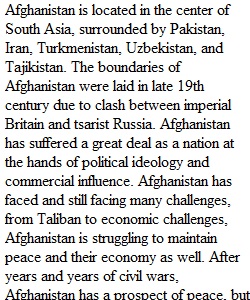


Q IS 312 Developing Country Policy Plan: Part II (190 pts.) Paper 110 pts./ Poster 50 pts./ Presentation 20 pts./ Peer Worksheet 10 pts. Due: Policy Plan and Poster due to Canvas May 18 by 11:59 PM PT Poster and Presentation in-class May 17 12:45 PM – 2:45 PM Welcome to the Developing Country Project Part II Overview: Over the semester we have read and learned about theoretical issues, arguments, and approaches to development. You have researched your country; it is time to design a policy plan to meet its development goals. Special emphasis to be given to the Three C’s: COVID 19, Climate Change, and Conflict. Paper (110 pts.) Your plan must include the Three C’s: COVID 19, Climate Change, and Conflict on development in your country and how they will be addressed. If your country is not challenged by one of the Three C’s, provide an explanation and evidence of why not. What you need to include in your plan: 1. Provide a Country Context (overview) this will be based on your Country Profile, and Sustainable Development Goals (SDGs), and fragile state assignments information. ? Include information that is important for a reader to know about your country, e.g., location, population data, economic data, the Three Cs etc. 2. Pick 3 – 4 critical Sustainable Development Goals (SDGs) that you, as the expert, think your country must prioritize. ? Explain the status of these critical SDGs (see the most recent UNSDG Report) and the impact of the Three Cs on these SDGs. 3. Design a development plan for your country to meet these critical SDGs. ? Connect to the development approaches and or theories examined in class. ? How will your plan mitigate the impact of the Three Cs? ? This section is the most important and word count should reflect this. 4. Conclude with what you see are the prospects for your country on its development path. Paper Format 1. 1250 – 1600 words. Include your word count. 2. Cover page, double-spaced, one-inch margins, 12 font, page numbers. 3. Minimum ten (10) academic sources. Includes your sources from Part I. 4. Parenthetical citation, MLA (Links to an external site.) for works cited page. 5. Turnitin will be enabled. Turnitin scores over 30% will not be accepted. 6. Upload to Canvas. Save your paper as Text (.txt), Microsoft Word (.doc/.docx), Portable Document Format (.pdf), Rich Text Format (.rtf), or Open Office Text (.odt) 7. Please be mindful of all directions. Submissions that do not follow all the directions will be subject to a 20% grade. Poster (50 pts.) 1. You can do anything you want with the poster. You can make a collage, do original artwork, you can use PowerPoint (max 4 slides), you can use Infographics, or you can do a traditional poster. Below you will find two links to help with poster presentations. 2. During the presentations, you will be presenting your Development Plan to your colleagues by referring to the poster. 3. Your colleagues will be asking questions and making comments, and scoring your presentation. 4. Your presentation may be recorded. 5. Upload your poster into the Canvas. If you are doing a traditional poster then take a picture and upload it. https://piktochart.com/formats/infographics/ (Links to an external site.) https://www.canva.com/infographics/templates/education/ (Links to an external site.) https://urc.ucdavis.edu/sites/g/files/dgvnsk3561/files/local_resources/documents/pdf_documents/How_To_Make_an_Effective_Poster2.pdf (Links to an external site.) https://guides.nyu.edu/posters (Links to an external site.) Poster Presentation (20 pts.) You will have 10 - 12 minutes to present your poster and development plan to your group. Peer review (10 pts.) During your presentation, your colleagues will be filling out a peer review worksheet based on your presentation. PreviousNext
View Related Questions